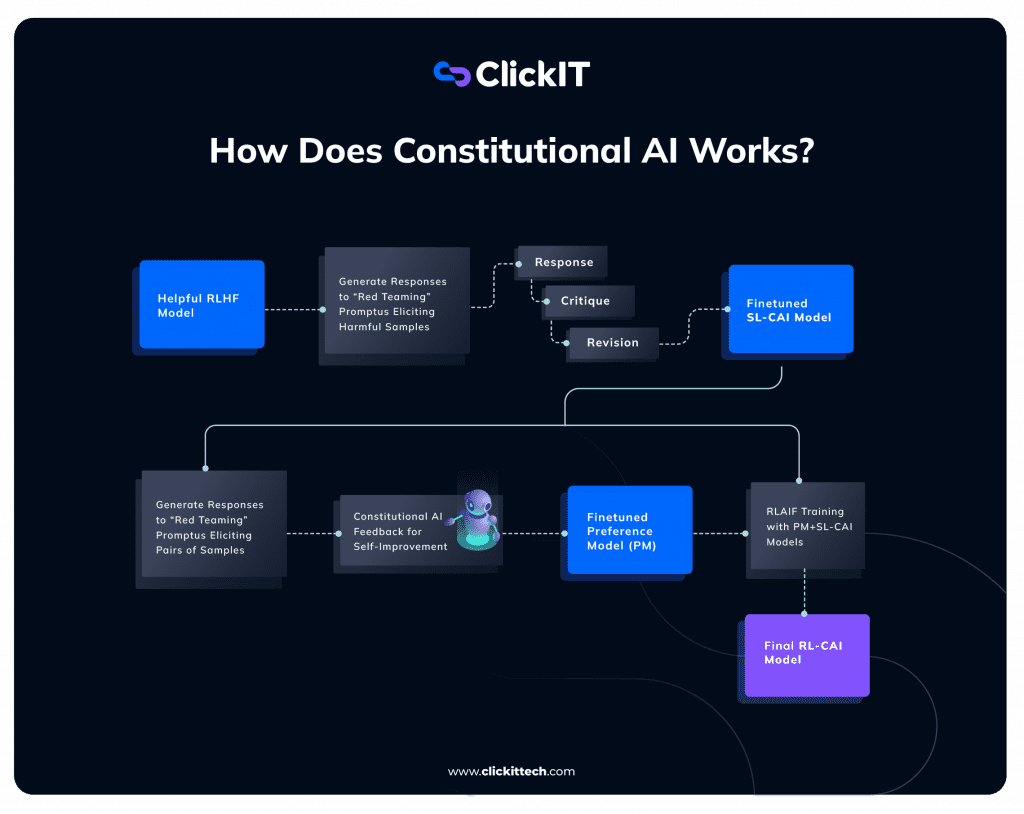AI systems are changing by the hour. And one of the top priorities, besides clarity and accuracy, is to ensure they work with safety and ethics. So, what is constitutional AI, and how does it help to achieve this goal?
Anthropic recognized the increasing capabilities of AI systems and decided to step in. They developed a set of ethical guidelines to embed directly into AIs. Sort of a defined “constitution”.
In this blog, I’ll explore the need for constitutional AI and its considerations. So, by the end of this read, you’ll be able to work with helpful, honest, and safer AI systems. Let’s dive in.
What is Constitutional AI?
Constitutional AI is an approach that involves training AI systems to follow a defined set of ethical and operational guidelines. Similar to what we know as a common constitution.
This “constitution” could refer to rules, values, and principles that the AI works by, resulting in a safer and more transparent behavior. Instead of just learning from the data that we’re feeding the AI, it learns how to use it, right from the training process and the model’s decision-making framework.
What Challenges Does Constitutional AI Solve?
Here are some of the challenges with conventional AI models that constitutional AI aims to solve:
- Bias and Discrimination: Historical data used to train some AI models could contain biases like stereotypes or unfair patterns. Without specific rules to identify and address them, the AI could sustain and even increase them.
- Misinformation and Harmful Content: Without a constitution, AI-generated content may contain inaccurate information that could spread misinformation or, in the worst cases, harmful material.
- Lack of Transparency: It’s usually unclear how traditional AI makes decisions, and this lack of transparency could be sensitive in areas like finance and healthcare.
- Ethical and Legal Compliance: Another challenge I find crucial is the need for AI systems to comply with ethical and legal requirements, which is also important in areas like finance and healthcare, as well as in every industry.
As Constitutional AI is integrated into the training process, it becomes easier to overcome or prevent these challenges. The AI system will be transparent and aligned with specific values.
So, as I reviewed the challenges constitutional AI aims to solve, we can see some clear benefits of embedding it into AI systems. I’ll go over some of them next.
What are the Benefits of Constitutional AI?
From my perspective, constitutional AI offers tangible benefits for everyone involved:
- For users: It means safer and more reliable interactions with AI systems.
- For Developers: It provides a structured framework to build and refine AI responsibly.
- For Regulators: It helps ensure that AI systems comply with emerging legal and ethical standards.
Overall, knowing that the AI I interact with or develop has a strong ethical foundation builds trust and confidence in the technology. Don’t you agree?
Staying ahead in AI requires staying informed.
Check out the Top AI Conferences in 2025 and mark your calendar.
What Are the Key Ethical Values Embedded in Constitutional AI?
Ethical considerations are at the core of constitutional AI. The “constitution” for an AI system usually incorporates values like:
- Fairness and Non-Discrimination: AI systems can’t favor one group over another.
- Transparency: Making the decision-making process understandable is essential for building trust.
- Accountability: There must be mechanisms in place to hold the AI (and its developers) responsible for its outputs.
- Privacy and Security: Protecting user data is non-negotiable, and AI must respect personal privacy.
- Safety: Preventing harmful outputs, especially in high-stakes applications like healthcare is crucial.
How Do These Ethical Guidelines Shape AI Behavior?
As I mentioned before in this blog, these key ethical values are integrated since the AI’s training process, so the system learns to make its decisions according to these ethical criteria.
For example, if it’s not sure about providing advice about a sensitive topic, it might suggest consulting with a professional. Or it can decide to allow or flag content, considering free speech and user protection as well.
| Risk in Traditional AI | Solution with Constitutional AI |
|---|---|
| Bias and Discrimination: AI models trained on historical data may absorb and replicate biased patterns. | Ethical Guidelines for Fairness: The constitution explicitly includes rules to avoid biased or unfair outputs. |
| Misinformation and Harmful Content: AI can generate false information or unsafe content. | Content Safety Rules: The model is trained to avoid harmful outputs like hate speech or misinformation. |
| Lack of Transparency: AI often acts like a “black box,” making decisions we can’t easily explain. | Clear Moral Framework: The constitution gives visibility into the model’s decision-making priorities. |
| Legal and Ethical Non-Compliance: Regulations are growing, and many models don’t meet new standards. | Built-in Legal Alignment: The constitution can include privacy, safety, and ethical compliance from the start. |
How Does Constitutional AI Work?
I’ve come to appreciate the technical foundation of Constitutional AI, which is a mix of traditional machine learning techniques and reinforcement learning from human feedback (RLHF).
Let me walk you through the process as I understand it:
1. Establishing the Constitution
First things first, the journey begins with experts crafting a detailed set of guidelines, a “constitution” for the AI.
This is a comprehensive framework that outlines ethical, legal, and operational principles that the AI must follow. For instance, one rule might be, “avoid generating hate speech,” while others can focus on preserving privacy, ensuring fairness, and even promoting transparency.
This stage is particularly important because it sets the moral compass that the AI will use as a reference point throughout its learning process.
2. Data Annotation and Supervision
Once we’ve got the rules, it’s time to show the AI what following them looks like. Human reviewers go through huge amounts of training data (like conversations, articles, or answers) and tag each piece based on the rules. They decide what’s okay and what crosses the line.
This is how we help AI learn the difference between simply repeating data and actually understanding what’s appropriate.
3. Reinforcement Learning from Human Feedback (RLHF)
After initial supervised learning, the AI model is further refined using reinforcement learning from human feedback. Here, the process becomes highly dynamic: the model generates outputs, and human evaluators assess whether these outputs align with the constitutional guidelines.
If the output meets the standards, the model receives a reward; if not, it faces a penalty. This reward-based system encourages the AI to favor responses that comply with the ethical framework.
I find this part of the training particularly innovative because it allows the AI to learn from its “mistakes” in a controlled environment and continuously improve.
4. Continuous Monitoring and Iterative Feedback
The process doesn’t end with deployment. I’ve learned that continuous monitoring is a key component of constitutional AI. Even after initial training, the system undergoes regular audits and real-world testing.
Human evaluators closely monitor the AI’s outputs and provide ongoing feedback to ensure the model remains consistent with its constitutional values.
This feedback loop means that the guidelines can be updated, and the AI can be retrained as new ethical challenges arise or societal values evolve. It’s a dynamic process that ensures the AI isn’t locked into outdated rules but can adapt over time.
5. Integrating Dynamic Scenario Simulations
Apart from traditional training methods, constitutional AI can involve simulating diverse scenarios that the model might encounter in the real world. This approach tests the AI under several conditions, ensuring that it can handle unexpected or complex situations while still adhering to its constitutional framework.
By exposing the model to a wider list of potential challenges during training, developers can better prepare it for the complexity of real-life applications.
6. Balancing Flexibility and Rigor
For understanding what is constitutional AI, one of the aspects I find most impressive to analyze is how it balances flexibility with strict adherence to the defined ethical standards. The reinforcement learning process isn’t about enforcing strict rules but about creating an adaptable system that can evaluate context and variables.
Teams can maintain the balance by continuously refining the AI’s decision-making process through human feedback and by updating the constitutional guidelines as needed. It’s a continuous cycle of learning, feedback, and improvement that keeps the AI both strong and aligned with evolving ethical norms.
7. Technical Infrastructure and Integration
Behind the scenes, advanced machine learning frameworks, powerful computational resources, and well-organized data pipelines work together to ensure that each step completes smoothly and efficiently.
This integration is crucial for achieving the overall goal: creating an AI that can learn from huge datasets while staying loyal to a set of guiding principles.

This diagram from Anthropic shows how Constitutional AI works in two stages: first, supervised learning helps the model follow a set of values from a “constitution.” Then, reinforcement learning fine-tunes it using those same principles to improve its behavior and reliability.
How Is Constitutional AI Being Applied in Everyday Technology?
The exciting part of constitutional AI is that different industries are already implementing it. Here are five applications I’ve seen that stand out:
- Content Moderation on Social Media:
I noticed that social media platforms are increasingly leveraging constitutional AI to automatically filter out harmful content, such as hate speech, misinformation, and explicit material. - Healthcare Assistants:
AI-powered virtual assistants are being trained to adhere to strict ethical guidelines. For example, a healthcare chatbot might be programmed to avoid giving medical diagnoses directly and instead encourage users to consult a professional. - Financial Fraud Detection and Compliance:
By aligning AI behavior with regulatory requirements and ethical standards, these systems can efficiently flag suspicious activities, such as unusual transactions or fraudulent activities, while reducing the risk of biased decision-making. - Autonomous Vehicles and Robotics:
The field of autonomous vehicles is one of the most exciting applications. Constitutional AI eases the integration of ethical decision-making frameworks into self-driving cars and robotics. For example, they can prioritize pedestrian safety, even in challenging traffic scenarios. - Legal and Policy-Making Tools:
In legal and policy-making arenas, developers are creating AI tools to assist in drafting policies and summarizing case law without bias. By following a constitutional framework, these tools allow legal professionals to make more informed and impartial decisions.
What Is the Bottom Line on Constitutional AI?
So, after this deep dive into what is constitutional AI, the steps to implement it, and its applications, I truly believe it’s a powerful approach that must be handled responsibly.
Constitutional AI provides a strong framework to develop AI systems that are both innovative and ethical. It helps developers reduce bias, misinformation, and even harmful outputs that couldn’t otherwise be controlled.
For me, it’s a smart move to transform the way we interact with technology. Set boundaries and make an effort to provide safer, more transparent, and more accountable AI systems.
There’s still a long way to go and an infinite amount of advancements in AI that we’ll see this year, but I see constitutional AI becoming a crucial part of it that should adapt and evolve as society does.
Ready to build more responsible AI? Start your AI project with us.
FAQ About Constitutional AI
These principles are integrated into the AI model through a technique called Reinforcement Learning from AI Feedback (RLAIF). In this process, the AI evaluates its own responses based on the constitutional guidelines. Rewarding itself for outputs that align with these principles. Over numerous training iterations, this self-reflection helps the AI internalize and adhere to the desired ethical standards.
While Constitutional AI significantly reduces the need for human intervention, it doesn’t entirely eliminate the need for human oversight. Human judgment is still important for addressing complex ethical dilemmas. And ensuring that AI systems operate within the boundaries of societal values.
It’s important to view these principles as living documents that should evolve alongside advancements in AI capabilities and changes in societal values. Establishing a process to periodically review and update the constitution ensures that the AI’s behavior remains aligned with current ethical standards and societal expectations.






